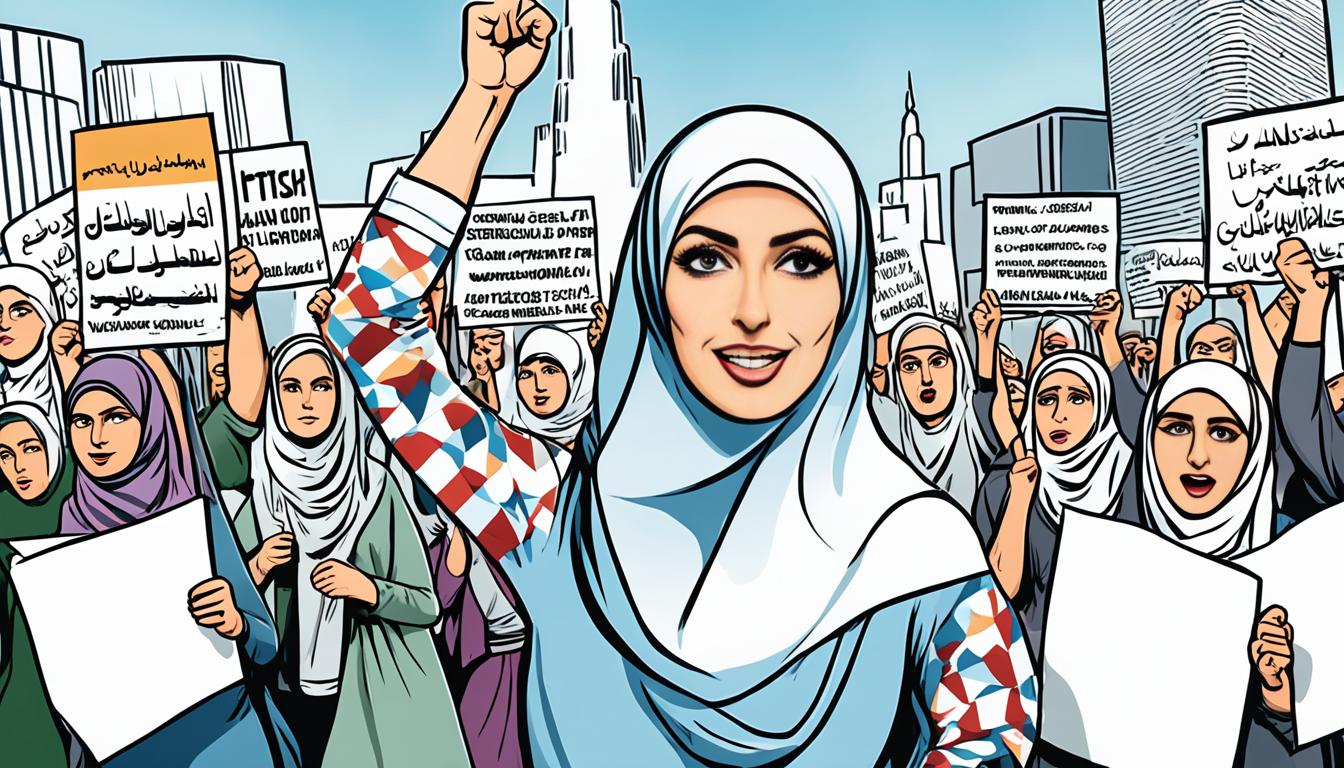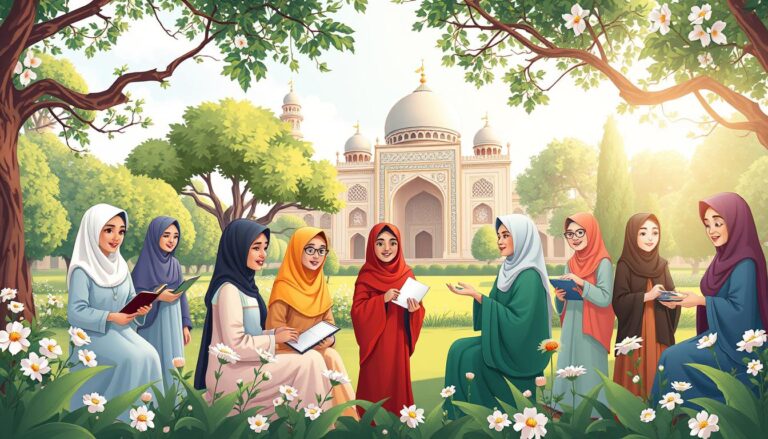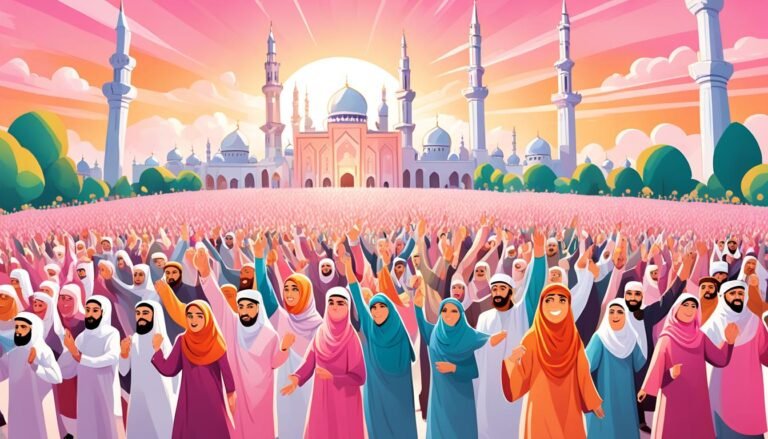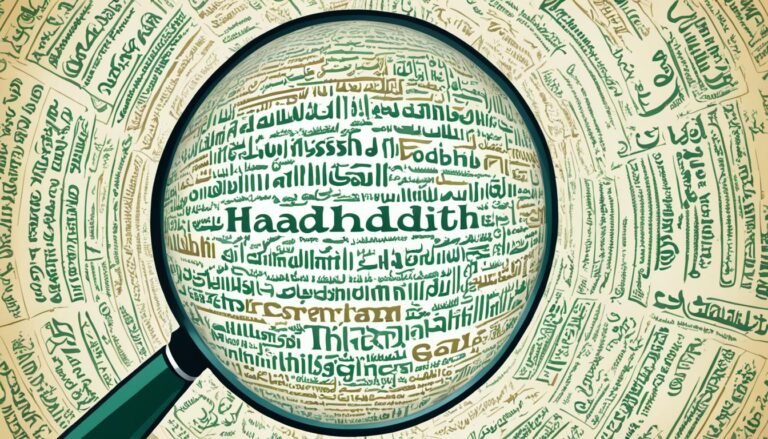Islamic Feminism: Challenging Patriarchal Norms
What if the key to understanding women’s rights in Islam is to challenge old patriarchal norms? Islamic feminism is a key movement that sheds light on Muslim societies. It calls for a new look at traditional practices to support gender equality. This movement aims to bring back Islamic teachings that support women’s rights and tackle the challenges Muslim women face.
Scholars like Ambar Ahmad say “Islamic feminism” is hard to define. This shows the many ways feminism and Islam are practiced around the world.
Looking at history and the fight against old views, we see how complex gender issues are in the Islamic world. As we explore Islamic feminism, we see its power to change stories and empower women.
Key Takeaways
- Islamic feminism focuses on the Qur’an’s parts that support equality and women’s rights.
- This movement is part of a bigger effort to reform Islam, challenging old views of men and women.
- Meeting European ideas has sparked talks on women in Islam in different places.
- Important thinkers have brought new ideas that support equal rights for all.
- Even with its progress, Islamic feminism still has to deal with some views that keep men in charge.
Understanding Islamic Feminism
Islamic feminism is a movement that aims to improve women’s rights in Islam. It challenges old views of religious texts and fights for gender justice. Scholars say we need to look at holy texts in a new way, focusing on women’s lives and rights.
Ijtihad, or independent reasoning, is key to Islamic feminism. It means re-reading religious laws to find new meanings. This helps bring out the importance of gender equality in Islam. It also starts a conversation that includes religious and cultural views.
In Iran, we see how Islamic feminism plays out in different ways. Some ignore it, while others support it. Scholars like Amina Wadud and Ziba Mir-Hosseini offer new views on sacred texts. They challenge old ideas that keep women unequal.
Islamic feminists believe we must understand the history behind religious texts. They say some verses, like verse 4:34, are misused to justify violence against women. By looking at the context and power issues, they aim to change how we see women’s rights in Islam.
This movement is about doing research for justice and seeking equality in Islamic views. It encourages Muslim women to take charge of their lives and stand up for their rights. At the same time, they stay true to their faith.
The Historical Context of Women’s Rights in Islam
The story of women’s rights in Islam is complex, filled with both empowerment and oppression. From the beginning, women had big rights like owning property, getting an education, and inheriting things. These were big steps forward in the early days of Islam, showing a change in how men and women were seen.
But over time, these rights got lost as men took over the interpretation of Islamic texts. This meant women’s voices were often ignored. Still, women like Tahirih Qurrat al-‘Ayn fought for women’s rights in the mid-1800s.
In the 19th century, women’s rights in Islam started to get a closer look. With Islamic modernism, people began to question and change women’s roles and rights. Scholars like Amina Wadud have been key in this fight, pushing for women’s rights in Islam.
Today, Muslim women face a mix of cultural and religious challenges. Their fight shows both the power and the limits they face. Allies and a fresh look at religious teachings are crucial as they work towards equality.
| Historical Context | Key Events | Impact on Women’s Rights |
|---|---|---|
| Early Islam | Rights granted to women (inheritance, education) | Established a foundation for women’s empowerment |
| 19th Century | Emergence of Islamic feminists like Tahirih | Initiated important dialogues on rights |
| Modern Movements | Rise of reinterpretation of texts | Reinforced women’s agency within Islam |
Islamic Feminism: Challenging Patriarchal Norms
Islamic feminism is a key way to challenge old beliefs in Muslim societies. It focuses on getting back women’s rights and giving women a stronger voice. By looking at the key concepts of Islamic feminism, we can understand its goal to change society.
Key Concepts of Islamic Feminism
At the heart of Islamic feminism is rethinking the Qur’an and Hadith. Scholars argue that we should consider the time and culture these texts were written in. This helps separate cultural traditions from true religious teachings. It also leads to new ways of understanding Islam that include women’s stories and rights.
Creating spaces just for women, like the all-women’s mosque in Tamil Nadu, is another key idea. These places let women talk about religion without men telling them what to do. Scholars like Kecia Ali, Asma Barlas, and Rania Awad also challenge old beliefs, offering new views on Islam.
Common Misconceptions
Many people misunderstand Islamic feminism, thinking it’s about women having no power or that Islam is against gender equality. Shabana Mir points out that women scholars are often seen as less skilled or less knowledgeable than men. These wrong ideas make people confused about what Islamic feminism really is.
Talking openly and teaching others about Islamic feminism helps clear up these wrong ideas. Muslim women are leading projects on mental and sexual health, showing they are powerful and care about their communities. As Muslim women connect with each other, they can fight back against misconceptions about Islamic feminism. This leads to a better conversation about gender equality in Islam.
Emergence of the Muslim Feminist Movement
The Muslim feminist movement marks a big change in women’s rights in Islam. It comes from the Islamic reform movement. This has led to new ways of understanding the Qur’an, focusing on justice and equality.
Activists use these new views to fight for women’s rights in both spiritual and social areas. They push for women to have their place in society.
Influence of the Islamic Reform Movement
The Islamic reform movement has changed how we talk about gender equality. Groups like Musawah, started in 2009, bring together activists from 47 countries. They work for gender equality in Islam.
Sisters in Islam, founded in 1988, encourages women to stand up against oppression. They use Islamic teachings in a new way. Marina Mahathir, for example, talks about how the Qur’an can support women’s rights.
Modern Interpretations and Activism
Today, feminist activism in Islam challenges old, male-led views of religious texts. Groups like Musawah rethink Sharia laws, saying they should be open to discussion. They believe people, not just scholars, should interpret them.
Legal changes in places like Morocco show progress. Marriage is now seen as a partnership thanks to women’s activism. This shows how women are using religious arguments to fight for their rights.
Strategies Employed by Islamic Feminists
Islamic feminists use different strategies to push for gender equality in Islam. They focus a lot on reinterpreting the Quran to match today’s values on women’s rights. This means they study the history behind certain verses to find a deeper meaning that challenges old beliefs.
Reinterpreting the Quran for Gender Equality
Islamic feminist scholars believe it’s important to look at the Quran in a new way. They work hard to show that the Quran talks about justice and equality. These scholars use critical thinking to find a fairer understanding of the Quran.
Historical Contextualization and Holistic Reading
By looking at the history of Quranic verses, feminists can find new meanings that support equality and justice. This approach considers the social and cultural settings that shaped these verses. It helps create a story where women’s rights are based on Islamic values, challenging unfair social norms.
The Role of Tawhid in Feminist Thought
The idea of Tawhid, or the oneness of God, is key in Islamic feminist thought. It teaches that all people are equal, which means gender inequality goes against this belief. By using Tawhid, Islamic feminists fight for women’s rights in a way that respects their faith and seeks justice.
Challenges Faced by Islamic Feminists
Islamic feminists face many hurdles in their fight for gender equality. They deal with strong resistance from those who don’t want to change old beliefs. This makes it hard to make Islamic texts support women’s rights. Cultural norms often clash with religious beliefs, making things even tougher.
Also, Islamophobia affects how people see Islamic feminism. It distorts the real goals of these movements. This makes it harder for them to get support.
Resistance from Patriarchal Structures
Patriarchal structures are a big obstacle for Islamic feminists. They don’t want to change the old ways, which slows down progress towards equality. In many places, women are still seen as not being equal, especially in the Middle East and North Africa.
Countries like Saudi Arabia and Afghanistan are far behind in treating men and women equally.
Cultural vs. Religious Norms
Cultural norms often get mixed up with religious beliefs, making it hard to push for gender equality. It’s important to know the difference between cultural traditions and true Islamic teachings. These differences can lead to disagreements, making it hard to work together.
Islamophobia and Its Impact
Islamophobia is a big problem for Islamic feminists. It leads to wrong ideas about Muslim women and their rights. This makes it harder for them to achieve their goals and find supporters.
After 9/11, things got even worse. Islamic feminists now face more challenges and discrimination.
Intersectionality in Islamic Feminism
Exploring intersectionality in Islamic feminism helps us see the varied experiences of Muslim women worldwide. It’s key to understand how race, class, and gender affect activism and the challenges women face in Islamic societies. As we look at global women’s issues, we see how these factors add depth to the fight for women’s rights in Islam.
Race, Class, and Gender Dynamics
More Muslim women are embracing intersectional feminism, showing a shift in awareness and support. This rise highlights the complexity of Muslim women’s identities. It shows that feminism in Islam is not one-size-fits-all. Key points include:
- The theological importance of Muslim women, as seen in the Quran and Sunnah.
- Worries about men holding too much spiritual power in many Muslim groups.
- Debates over women leading mixed-gender prayers, showing community divisions.
The movement aims to challenge old, patriarchal views of Islam. It fights the idea that feminism attacks traditional masculinity, especially with older folks. The push for women to lead in spiritual matters shows a big change in how we see gender roles.
Global Perspectives on Women’s Issues
Looking at women’s issues through Islamic feminism shows a wide range of activism. Cooke et al. (2008) introduced the term ‘Muslimwoman’, showing how religion and gender are linked, especially after 9/11. This event changed how people see hijab-wearing Muslim women, often unfairly judging and discriminating against them.
On March 27, we celebrate International Muslim Women’s Day, a time to reflect on the challenges and wins of women. Stories of Muslim women facing humiliation in places like airports highlight the need for change. These stories show how race, gender, and class affect women’s lives and rights. This global conversation is key to achieving equality for women in Islam.
| Key Developments | Impact on Women | Community Response |
|---|---|---|
| Increasing identification with intersectional feminism | Empowerment through understanding complex identities | Growing acceptance of women’s roles in spiritual leadership |
| Introduction of female muftis | Greater representation within Islamic scholarship | Resistance from traditional clerics |
| Celebration of International Muslim Women’s Day | Empowerment and awareness within and beyond communities | Diverse participation across Muslim-majority countries |
Empowerment of Muslim Women through Feminism
Empowering Muslim women is a key goal in the feminist movement. It’s linked to efforts in advocacy and education. These aim to support women’s rights and their freedom to choose. Through feminist case studies, we see how these efforts have made a big difference. They’ve created a culture of equality and respect.
Case Studies of Successful Movements
Many feminist case studies show how Muslim women have fought for their rights. For instance, in Morocco, campaigns led to more legal rights for women, like inheritance and divorce. These efforts show how community actions can challenge old beliefs and empower women.
They highlight the power of working together to fight for women’s rights in different Islamic settings.
Role of Education in Empowerment
Education is a powerful tool for empowerment. In many places, special programs for women have changed lives and communities. These programs improve women’s economic and social status.
They also help women stand up against discrimination and claim their rights. Initiatives focus on teaching about gender equality. They provide skills and leadership chances, helping women in their empowerment journey.
Breaking Gender Stereotypes in Islam
Looking into gender stereotypes in Islam means we must question old stories that show women as less important. Islamic feminists are key in fighting these stories. They push for women to be shown in a better light in religious settings. They use old texts and new views of Islamic teachings to show women’s true roles and successes.
Challenging Traditional Narratives
Islamic feminism is changing the way we see old wrong ideas. Muslim women are joining together and speaking out for equal rights. They study religious texts to change how we see women’s roles in Islam. This helps challenge what people think and brings a clearer story of women’s place.
Positive Representation of Women in Islamic Texts
Islamic texts have many stories of women’s big roles in society, but these are often missed because of old gender ideas. Islamic feminists highlight these stories to show that Islam values fairness and justice. This new look not only raises women’s status but also lets them talk about religion as equals with men.
Gender Equality in Islamic Societies
The debate on gender equality in Islamic societies is complex. It looks at different views and changes in laws. It shows how Islamic teachings are being applied today to support women’s rights.
Comparative Analysis of Different Perspectives
Views on gender equality in Islamic societies vary widely. Fatima Mernissi, a feminist and sociologist, says many think Islamic women are oppressed because of wrong interpretations of the Quran. She believes cultural practices can twist Islamic values, not show them. Gerda Lerner, a historian, looks at how patriarchy grew over time, showing the long history of male dominance.
- Only 8% of Muslim-majority countries have had a female leader.
- Women in these countries make up less than the world average of 24% in parliaments.
- Female literacy often trails behind that of males in these areas.
Yet, there’s a move towards change. Iranian scholar Nesta Ramazani talks about Islamic feminism. She argues it challenges old gender biases in Islamic texts, pushing for women’s legal rights.
Recent Advances in Gender Equality Laws
Many Islamic countries are updating their laws to match modern views on gender equality. They’re focusing on laws about inheritance, divorce, and child custody. Progressive scholars are speaking out for gender justice, challenging old norms in their communities.
Democracy and gender inequality are linked, with more democracy helping women’s rights. Child rights talk is also changing conservative views, expanding what’s seen as right in traditional settings. These changes show how culture, religion, and gender equality interact in Islamic societies.
The Global Impact of Islamic Feminism
Islamic feminism is changing the world, reaching beyond borders. It brings together different feminist views, showing the power of working together. Women’s rights are at the heart of this movement, challenging old beliefs in many cultures.
Influences Beyond Islamic Nations
Islamic feminism’s reach goes far, affecting feminism worldwide. It tackles issues like violence against women, reproductive rights, and fair representation. Scholars like Dr. Aziza al-Hibri and Dr. Asma Lambrabet are rewriting Islamic texts to match today’s human rights. This work helps tell a new story of gender equality.
Collaborations with Secular Feminist Movements
Islamic and secular feminists are joining forces for women’s rights. They share common goals but respect their differences. These partnerships open up a wider conversation about women’s issues, fighting wrong beliefs about Islam and feminism. Working together, they gain a deeper understanding of gender equality across the globe.
Conclusion
Islamic feminism is a strong answer to deep-rooted male dominance. It fights for women’s rights by deeply understanding Islamic texts. This article shows that even though some religious leaders and secular feminists disagree, the push for gender equality in Islam is urgent.
The path to gender equality is tough but full of hope. Islamic feminism is showing its strength. It’s about making sure women have the same rights as men in Islam.
Women’s rights in Islam are more important than ever. This movement is about making sure women are treated fairly in their communities. It’s a fight for equality and justice.
Islamic feminism is gaining ground as activists and scholars work to change religious texts. They’re creating safe spaces for women to talk about their faith. Scholars like Fatima Mernissi and Assia Djebar are leading the way in highlighting women’s stories.
In countries like Iran, there’s a big gap between what women are allowed to do and what they actually can do. This shows why women’s rights in Islam are crucial for society to move forward. Feminists, both religious and secular, must work together to create a world where women’s stories are valued everywhere.
Source Links
- A Social Psychological Critique on Islamic Feminism
- Event Report | Feminism(s) | Part I: Islamic Feminism – Polis180
- Islamic feminism – a contradiction in terms?
- Breaking stereotypes: Islamic feminism and HCI
- Women and the Qur’an: Feminist Interpretive Authority?
- The War on Muslim Women’s Bodies: A Critique of Western Feminism
- Islamic feminism
- Islamic feminism – a contradiction in terms?
- Female Scholarship In Islam Is Challenging Patriarchal Leadership – Preachy
- The Rise of the Islamic Feminists
- Muslim Women’s Religious and Feminist Identities: A Study of Muslim Feminism in the Bosnian Context
- Islamic Feminism: A Discourse of Gender Justice and Equality
- Revisiting the islam-patriarchy nexus: is religious fundamentalism the central cultural barrier to gender equality? – Zeitschrift für Religion, Gesellschaft und Politik
- Dilemmas of Islamic and Secular Feminists and Feminisms
- Muslim Feminists Are Not Here For Your Misconceptions About Their Faith
- 6. (Dis)embodied Intersectionality
- Critique Internationale
- Controversies, Complexities and Contexts: Teaching Islam through Internal Feminist Critique of the Religion
- Islam and Patriarchy – and why it’s important to understand
- Five things you need to know about women in Islam: Implications for advancing women’s rights in the Middle East
- Interdisciplinary Approach to Overcoming the Persistence of Patriarchal Islamic Interpretations: Gender Equality, the Development of Empathy and Children’s Rights, and Insights from the Reformist Eurasian Scholars of Early Twentieth Century
- The Fundamental Contradiction of Islamic Feminism







